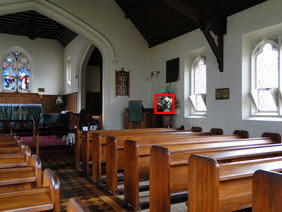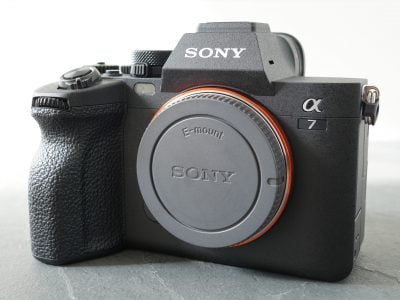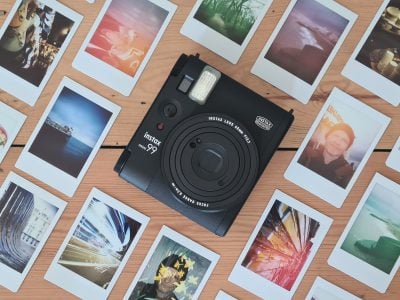Sony Cyber-shot DSC-HX1
-
-
Written by Gordon Laing
Sony Cyber-shot HX1 vs Canon SX1 IS vs Nikon D90 High ISO noise
Sony Cyber-shot HX1 Noise ReductionMany of Sony’s previous Cyber-shot cameras applied more noise reduction than you may have wanted, resulting in smeared-looking results at times. The HX1 addresses this by simply not applying as much noise reduction to start with, but by additionally giving you the choice of reducing – or increasing – it a notch. Below are crops taken from three images taken at 400 ISO, from left to right with the Noise Reduction set to NR-, NR STD and NR+. In our view, Sony’s taken a sensible approach with the standard setting, reducing visible speckles, but not so much that it smears out detail. The NR- option may however be preferable to those who wish to apply third-party noise reduction later. Now for more real-life examples across its sensitivity range, check out our Sony Cyber-shot DSC-HX1 sample images page. |
Sony Cyber-shot DSC-HX1 Noise Reduction: NR- |
Sony Cyber-shot DSC-HX1 Noise Reduction: NR STD |
Sony Cyber-shot DSC-HX1 Noise Reduction: NR+ | ||
 |
 |
 | ||
400 ISO |
400 ISO |
400 ISO |
Sony Cyber-shot DSC-HX1 results
Real-life resolution / Studio resolution / High ISO Noise
|
 | To compare noise levels under real-life conditions we shot this scene with the Sony Cyber-shot DSC-HX1, Canon PowerShot SX1 IS and Nikon D90 within a few moments of each other using each of their ISO settings. The lenses on each camera were adjusted to deliver the same vertical field of view. The image left was taken with the Sony Cyber-shot DSC-HX1 at 6mm f2.8 and with a sensitivity of 125 ISO; the original JPEG measured 3.66MB. The crops are taken from an area marked by the red square and presented here at 100%. |
Note the Nikon D90 captures wider 3:2 aspect ratio images, so by matching the vertical field of view, we’re effectively treating the DSLR here as a 10.8 Megapixel camera, delivering 4:3 shaped images.
The Canon PowerShot SX1 IS kicks-off this sequence at 80 ISO with a detailed result, although one in which pixel-peepers will already notice subtle noise textures in the background. The next row introduces the Sony Cyber-shot DSC-HX1 at its base sensitivity of 125 ISO and the Nikon D90 at its Lo setting, equivalent to 100 ISO. We’ve included a DSLR in this sequence to illustrate their high ISO benefits over compacts, and to dispel any myths that having a CMOS sensor in a super-zoom somehow equips it with low noise capabilities.
The Sony HX1 crop at 125 ISO may contain plenty of detail, but equally there’s visible noise and processing textures in the background. The Canon SX1 IS is also showing a slight increase in noise over its 80 ISO sample, but softer processing means it’s not as obvious as that on the Sony. In the meantime, the Nikon D90 is unsurprisingly delivering a very clean and noise-free result, although as saw with the Canon DSLR on the first results page, the image is less-sharpened than the super-zooms.
At 200 ISO, the Canon SX1 IS shows another slight increase in noise levels, although the Sony stays roughly the same as before – so both cameras are roughly neck-in-neck at this point. The D90 of course remains un-phased by this increase in sensitivity, to its base level.
With the sensitivity doubled to 400 ISO, the two super-zooms are visibly suffering more than before, but in different ways. The Canon is gradually losing detail and saturation, while the HX1 (unusually for a Sony) appears to eschewing noise reduction for visible speckles. We prefer the Sony to the Canon at this sensitivity. Meanwhile, pixel-peepers may notice tiny evidence of textures on the Nikon sample, but to all intents and purposes, it’s still perfectly clean.
At 800 ISO, noise levels have increased and saturation reduced on the Sony, but it’s still arguably preferable to the Canon SX1 IS which is looking quite patchy in comparison. At this point you can really see the benefit of a DSLR, which despite a small amount of noise making an appearance, still looks considerably cleaner.
At 1600 ISO, the Sony HX1 takes another step towards a monochrome image with lots of visible grain, but again it remains much preferable to the Canon SX1 IS where heavy processing has had a detrimental impact. And the Nikon D90? Still looking pretty good.
Both super-zooms top-out at 3200 ISO, although while the Canon significantly drops its resolution to just 2 Megapixels, the Sony bravely attempts to record its full 9 Megapixels worth of information. Neither look particularly good, although the Sony has the edge when reduced to the same size.
Meanwhile, the Nikon D90 is beginning to soften, but it’s a world apart from the cameras with physically smaller sensors. Indeed its 6400 ISO result, which completes this sequence, has a similar amount of detail and noise to the super-zooms at 200 to 400 ISO.
Ultimately if you’re able to shoot at their lowest sensitivities, the Canon SX1 IS enjoys a small edge over the Sony HX1, but at 400 ISO and above, the Sony delivers what are arguably better-looking results. Much of this is down to its approach to image processing and noise reduction though, which you may or may not like.
Speaking of which, the HX1 offers three different Noise Reduction settings and we have examples of how they affect an image taken at 400 ISO at the bottom of this page. Alternatively, if you’re ready for more real-life examples across its sensitivity range, check out our Sony Cyber-shot DSC-HX1 sample images page.
Sony Cyber-shot DSC-HX1 |
Canon PowerShot SX1 IS |
Nikon D90 | ||
 |
 |
 | ||
80 ISO not available |
80 ISO |
80 ISO not available | ||
 |
 |
 | ||
125 ISO |
100 ISO |
L1.0 (100 ISO) | ||
 |
 |
 | ||
200 ISO |
200 ISO |
200 ISO | ||
 |
 |
 | ||
400 ISO |
400 ISO |
400 ISO | ||
 |
 |
 | ||
800 ISO |
800 ISO |
800 ISO | ||
 |
 |
 | ||
1600 ISO |
1600 ISO |
1600 ISO | ||
 |
 |
 | ||
3200 ISO |
3200 ISO (at 2 Megapixels) |
3200 ISO | ||
 |
 |
 | ||
6400 ISO not available |
6400 ISO not available |
6400 ISO |




